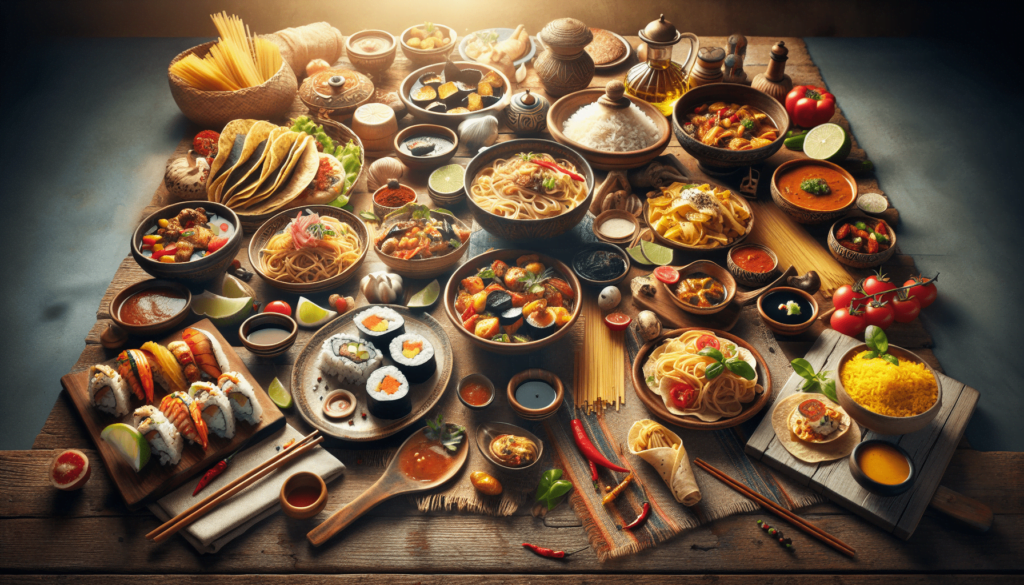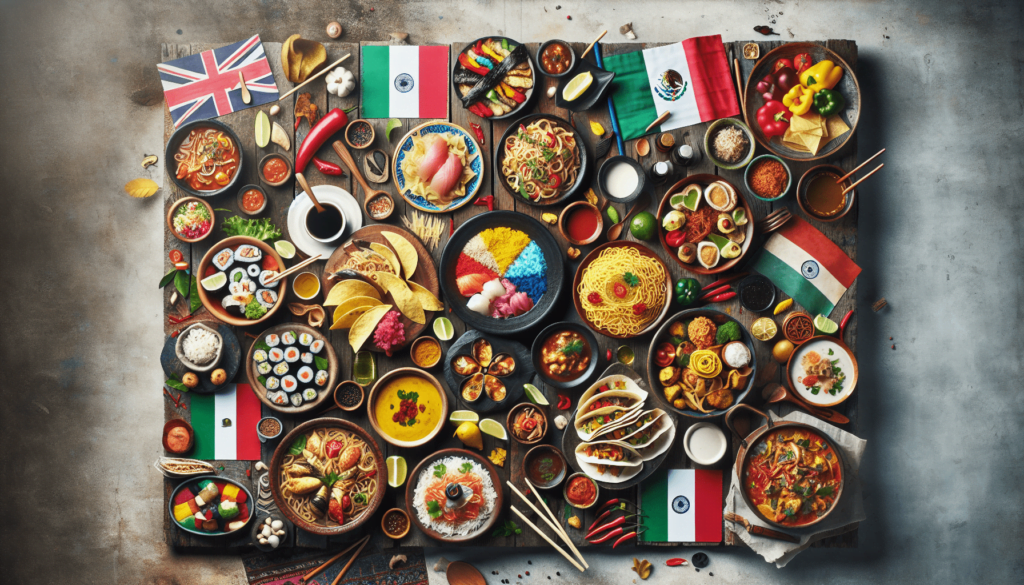“Feasting Around the World: A Food Blogger’s Journey” invites you to embark on a delectable adventure through the lens of a passionate food enthusiast. Imagine savoring aromatic spices in bustling Moroccan markets, indulging in delicate sushi at a hidden Tokyo gem, or relishing rustic Italian pastas in a sunlit Tuscan village. This article delves into the cultural, historical, and contemporary food experiences that define global cuisine, offering you a rich narrative that blends personal anecdotes, expert insights, and mouth-watering descriptions. By the end, you’ll have not only a deeper appreciation of diverse culinary traditions but also a whetted appetite for your own gastronomic explorations.
Table of Contents
Feasting Around the World: A Food Blogger’s Journey
Have you ever wondered what it would be like to eat your way around the world? The diverse flavors, unique textures, and fascinating culinary traditions that each country offers create an endless adventure for any food lover. Imagine turning this passion into a career, traveling the globe, and sharing your gastronomic experiences with an enthusiastic audience.

Overview
In today’s world, the concept of a “food blogger” has evolved beyond just posting recipes or restaurant reviews. It has become an exciting, multi-dimensional career that allows you to explore different cultures through their culinary practices. This journey is both a personal and a global exploration, providing a fascinating lens through which to see the world.
Thesis Statement
“Feasting Around the World: A Food Blogger’s Journey” delves into the life of a food blogger traveling across various countries, exploring their culinary traditions, and sharing these experiences with a global audience. This article will discuss the historical context of food blogging, current trends, key concepts, detailed explorations, and future directions in this rapidly evolving field.
Historical Context
Food blogging has its roots in the early 2000s when the internet began to flourish with personal blogs about everyday life. Initially a humble hobby, the practice quickly gained popularity as readers sought new recipes and culinary advice. Some early pioneers of food blogging started as amateur cooks, sharing family recipes and meal planning tips, gradually building a loyal following. As their influence grew, many transformed their passion projects into professional careers, establishing themselves as trusted sources in the culinary world.
Blogging platforms like Blogger and WordPress made it easier for anyone to create and share content, leading to an explosion of food-related blogs. Over time, the rise of social media platforms like Instagram and Pinterest allowed food bloggers to engage with audiences more visually, showcasing beautifully plated dishes and exotic ingredients.
Current Trends
Today, food blogging is more dynamic than ever. Several trends have emerged that redefine what it means to be a food blogger in the modern age.
Trend 1: Visual Storytelling
Visual content is king, with high-quality photos and videos becoming essential components of food blogging. Platforms like Instagram, TikTok, and YouTube are now indispensable for reaching a broader audience. Food bloggers often invest in professional photography and video equipment to create visually appealing content that engages followers.
Trend 2: Sustainable Eating
The rise in environmental awareness has led many food bloggers to focus on sustainable eating practices. Emphasis on plant-based diets, zero-waste cooking, and locally sourced ingredients reflects broader societal shifts towards sustainability.
Trend 3: Inclusivity
Unique voices and perspectives are increasingly valued within the food blogging community. Bloggers from diverse backgrounds are highlighting lesser-known cuisines and traditions, offering readers a richer, more inclusive view of global food culture.
Key Concepts and Definitions
To fully appreciate the topic, it’s helpful to understand a few key terms:
- Culinary Tourism: Traveling for the purpose of experiencing different foods and culinary traditions.
- Food Blogging: Creating and sharing content related to food, cooking, and culinary experiences through blogs and social media.
- Gastronomy: The study of food and culture, with a particular focus on gourmet cuisine.
- Sustainable Eating: Practices that promote environmental health, such as eating locally sourced or plant-based foods.
Detailed Exploration
Let’s break down the journey of a food blogger into several key aspects, starting from the initial idea to the real-world application and examples.
The Inspiration and Planning
Food bloggers don’t just wake up one day and start traveling the world. A great deal of inspiration, research, and planning go into every journey. Often, the inspiration comes from a love for cooking and an insatiable curiosity about different cultures. Planning involves researching destinations, understanding local cuisines, and reaching out to local chefs or food historians for authentic experiences.
Experiencing the Culinary Traditions
Once the blogger reaches their destination, they immerse themselves in the local food culture. This involves visiting markets, attending cooking classes, and dining at both roadside stalls and fine dining establishments. The goal is to understand the culinary traditions of the area and capture this knowledge in a way that is both educational and entertaining for their audience.
Creating Content
After gathering experiences and insights, the next challenge is creating content that captures the essence of these culinary journeys. This includes writing blog posts, creating videos, and sharing photos on social media. The content should be engaging, informative, and authentic, providing readers with a feel of what the food and culture are like.
Engaging with the Audience
Interaction with the audience is crucial for a food blogger. This involves responding to comments, hosting Q&A sessions, and sometimes even meeting followers in person. Engaging with the audience creates a loyal community and adds value to the content by addressing the interests and questions of readers.

Example 1: Exploring Tokyo’s Culinary Scene
Imagine the bustling streets of Tokyo, where food stalls and high-end restaurants co-exist in perfect harmony. For a food blogger, Tokyo offers a treasure trove of culinary experiences. From sampling street food like takoyaki (octopus balls) and taiyaki (fish-shaped cakes) to dining at a sushi restaurant where the chef serves sushi pieces directly onto your plate from a wooden counter. Each of these experiences not only teaches the blogger about Japanese cuisine but also offers numerous stories and photos to share with their audience.
Table: Must-Try Foods in Tokyo
| Dish | Description | Must-Visit Place |
|---|---|---|
| Sushi | Fresh raw fish on vinegared rice | Tsukiji Fish Market |
| Ramen | Noodles in a rich, flavorful broth | Ichiran Ramen |
| Takoyaki | Octopus balls | Street stalls in Shibuya |
| Matcha Desserts | Green tea-flavored sweets | Nakamura Tokichi Honten Tea |
Example 2: Savoring Indian Street Food
Traveling to India offers a completely different culinary adventure. India’s street food is renowned for its flavors, spices, and variety. A day in the life of a food blogger in India could involve tasting pani puri (crispy hollow balls filled with spicy water), samosas (deep-fried savory pastries), and jalebi (sweet, deep-fried rings soaked in sugar syrup). Each of these dishes tells a story about India’s rich food culture, which can be shared through compelling blog posts and vibrant photos.
Comparison of Different Perspectives
Food blogging is not just about glorifying one’s culinary experiences. It also involves understanding and comparing different perspectives. For instance, Western and Eastern culinary philosophies often differ significantly. Western cuisines might focus on presentation and precision, while Eastern cuisines may emphasize harmony of flavors and ingredients. A food blogger’s journey highlights these differences and fosters a greater appreciation for global food diversity.
Impact Assessment
The differing perspectives present a chance to comprehend the broader impacts these culinary traditions have on local and global scales. Understanding agricultural practices, family traditions, and economic factors behind certain foods can provide deep insights into why certain cuisines evolved as they did. Such understanding fosters respect and admiration for diverse culinary traditions and contributes to more informed and thoughtful food choices worldwide.
Future Directions and Implications
Predictions
Given the growing interest in sustainable eating and cultural inclusivity, future trends in food blogging will likely focus more on these aspects. Food bloggers might prioritize visiting farm-to-table restaurants, organic farms, and focusing on the stories of indigenous cuisines and local ingredients. The use of technology such as virtual reality (VR) could also enable immersive culinary experiences for readers who might not be able to travel.
Implications
The implications of these future trends are far-reaching. They could lead to a greater awareness of sustainable food practices and a deeper appreciation of different cultural culinary traditions. Food bloggers hold the power to influence their audience’s food choices, which in turn can drive global demand towards more ethical and environmentally friendly food options.
Conclusion
Recap
Through the exciting journey of a food blogger, we’ve explored the historical background, current trends, key concepts, detailed exploration of experiences, important examples, and different perspectives that make this career so fascinating. Each point collectively emphasizes how food blogging is more than just a hobby; it’s a unique window into the heart of global cultures.
Final Thought
So next time you sit down to a meal, whether it’s a simple home-cooked dish or an exotic restaurant’s offering, think about the stories, traditions, and cultures embedded in each bite. What narratives are waiting to be discovered on your plate?
Engagement
We’d love to hear from you! Have you ever considered starting your own food blog, or are you an avid follower of any food bloggers? Share your thoughts and experiences in the comments below. Don’t forget to share this article with your foodie friends and explore more resources on our blog.
Credible Sources
- Smith, A. F. (2007). Encyclopedia of Food and Drink in America. Oxford University Press.
- Leite, D. (2004). The New Portuguese Table: Exciting Flavors from Europe’s Western Coast. Clarkson Potter.
- Blogging.com. (2021). The History of Food Blogging. Retrieved from blogging.com/history-of-food-blogging
- SustainableFoodTrust.org. (2020). Sustainable Eating: Key Concepts and Definitions. Retrieved from sustainablefoodtrust.org/sustainable-eating
- Hamilton, N. (2016). Gastropolis: Food and New York City. Columbia University Press.
Taste the World: A Gastronomic Journey for the Culinary Enthusiast
